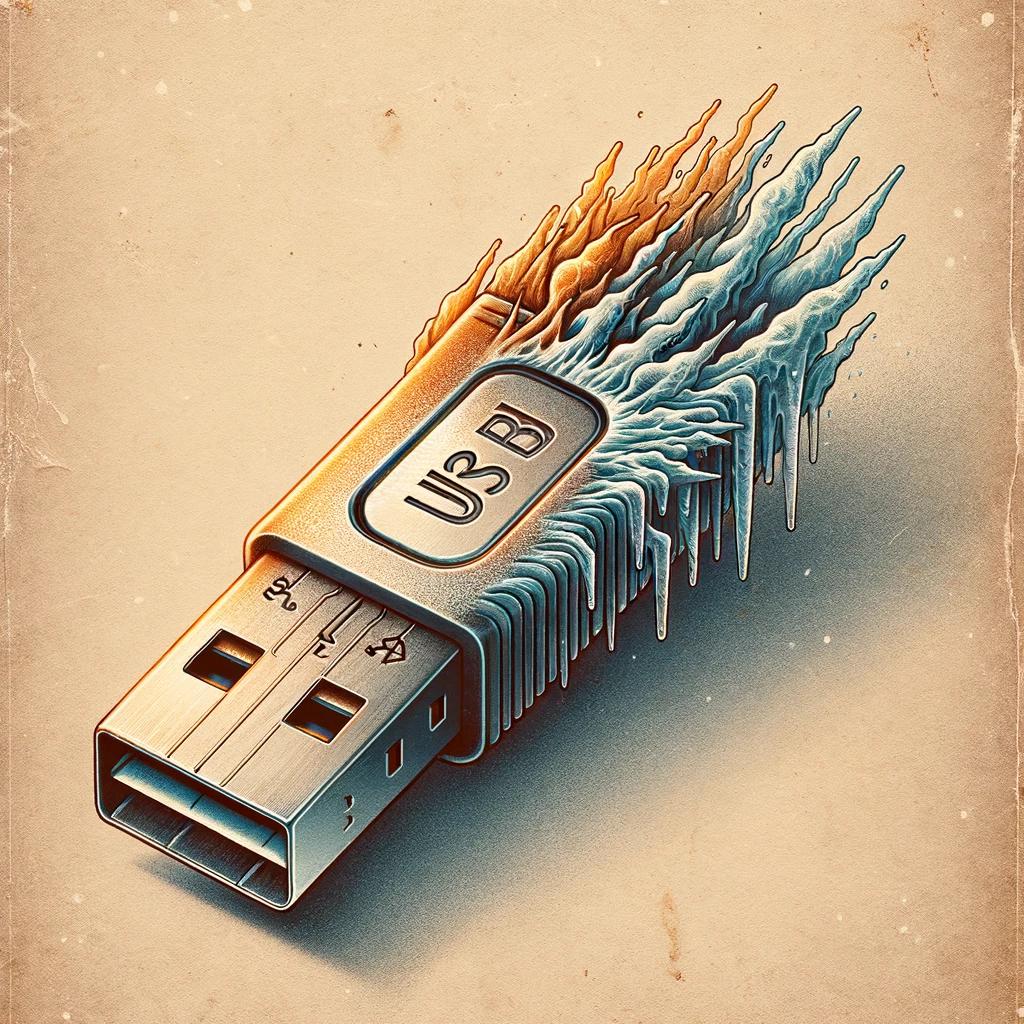Introduction
In an era dominated by digital data, USB sticks, also known as flash drives or memory sticks, have emerged as essential tools for storing and transferring information. These compact devices are prized for their portability, convenience, and ability to hold significant amounts of data. From office workers to students, photographers to IT professionals, USB sticks are a ubiquitous part of modern life.
However, despite their widespread use and reliability, USB sticks are not invulnerable to environmental factors. One of the key challenges they face is temperature sensitivity. Like all electronic devices, USB sticks can be affected by extreme temperatures, which can impact their performance and longevity.
Understanding the relationship between USB sticks and temperature is crucial for users who rely on these devices for important data. By recognizing the potential risks and taking steps to mitigate them, users can ensure their USB sticks remain functional and their data stays safe.
Understanding the Composition of USB Sticks
At the core of a USB stick is its flash memory chip, a silicon-based component responsible for data storage. This chip is surrounded by other critical parts, including a controller that manages data storage and communication with the computer, and a USB connector, often encased in metal for durability.
The materials used in USB sticks, such as metals, plastics, and silicon, have different responses to temperature changes. Metals can expand or contract with heat or cold, while plastics may become brittle in low temperatures or warp in high heat. Silicon, the material used for the memory chip, is particularly sensitive to temperature fluctuations.
The design of USB sticks aims to protect these components from everyday hazards, including temperature variations. However, despite these protective measures, extreme temperatures can still pose a risk to the integrity and functionality of the device.
The Impact of High Temperatures on USB Sticks
When exposed to high temperatures, USB sticks can experience several issues. The most immediate concern is data corruption. Heat can cause the memory cells in the flash chip to become unstable, leading to errors when reading or writing data. In severe cases, this can result in the loss of important files or the entire contents of the USB stick.
High temperatures can also cause physical damage to the USB stick. The metal parts may expand, leading to a loose connection with the computer's USB port. The plastic casing can warp or melt, compromising the device's structural integrity. Over time, repeated exposure to high heat can degrade the materials, reducing the lifespan of the USB stick.
Situations where USB sticks are likely to be exposed to high temperatures include leaving them in a car on a hot day, using them near heat sources like radiators or ovens, or operating them in environments with poor ventilation. Users should be mindful of these scenarios and take precautions to protect their devices.
The Effect of Low Temperatures on USB Sticks
Conversely, low temperatures can also impact USB sticks. One of the main concerns is condensation. When a cold USB stick is brought into a warmer environment, moisture can condense on its internal components. This moisture can cause short circuits or corrosion, leading to data loss or device failure.
Low temperatures can also make the materials in a USB stick more brittle. This increases the risk of physical damage, such as cracking or breaking, especially if the device is subjected to impact or pressure.
To protect USB sticks in cold environments, users should keep them in insulated cases or bags and allow them to gradually warm up to room temperature before use. Avoiding rapid temperature changes can help prevent condensation and reduce the risk of damage.
Optimal Temperature Range for USB Stick Performance
For optimal performance and longevity, USB sticks should be operated and stored within a specific temperature range. Typically, this range is between 0°C and 60°C (32°F and 140°F). Staying within these limits ensures that the materials and components function as intended, reducing the risk of temperature-related issues.
Maintaining this optimal temperature range requires some attention to storage and usage conditions. For example, users should avoid leaving USB sticks in direct sunlight, near heat sources, or in unheated spaces during cold weather. When not in use, storing the devices in a stable, climate-controlled environment can help preserve their integrity.
Preventive Measures to Protect USB Sticks from Extreme Temperatures
To safeguard USB sticks from the effects of extreme temperatures, users can take several preventive measures. First, it's important to be aware of the environments in which the devices are used and stored. Keeping them away from direct sunlight, heat sources, and cold drafts can prevent exposure to harmful temperatures.
Using protective cases can also provide an additional layer of insulation, helping to maintain a stable temperature around the USB stick. These cases can shield the device from sudden temperature changes and reduce the risk of condensation.
When traveling or transporting USB sticks, users should consider the potential for temperature extremes, especially in vehicles or outdoor settings. Keeping the devices in an insulated bag or container can help protect them from temperature fluctuations.
Recognizing and Responding to Temperature-Induced Malfunctions
If a USB stick has been exposed to extreme temperatures, there are signs that may indicate damage or malfunction. For example, the device may not be recognized by the computer, or files may be corrupted or inaccessible. In some cases, the USB stick may become physically deformed or show signs of condensation.
If a temperature-induced malfunction is suspected, the first step is to safely remove the device from the computer and allow it to return to room temperature. Avoid using heat sources or rapid cooling methods, as these can exacerbate the problem. Once the USB stick has stabilized, attempt to access the data and back up any important files.
If the device continues to malfunction, it may be necessary to seek professional data recovery services. In some cases, the damage may be irreversible, underscoring the importance of preventive measures and regular backups.
Future Trends in USB Stick Technology and Temperature Resistance
As technology advances, manufacturers are continually seeking ways to improve the durability and reliability of USB sticks, including their resistance to temperature extremes. Developments in materials science and design are leading to devices that can withstand wider temperature ranges without compromising performance.
Emerging technologies, such as advanced cooling systems and temperature-resistant coatings, are being explored to enhance the resilience of USB sticks. Additionally, innovations in flash memory technology are aimed at reducing the sensitivity of memory cells to temperature fluctuations.
The future of USB stick technology promises devices that are not only more robust in the face of environmental challenges but also offer greater storage capacities and faster data transfer speeds. As these advancements come to fruition, users can look forward to USB sticks that are even more reliable and versatile.
Exploring Alternatives: When USB Sticks Aren't the Best Option
While USB sticks are a popular choice for data storage and transfer, they may not always be the best option, especially in environments with extreme temperatures. In such cases, exploring alternative storage solutions can provide added security and reliability.
Cloud storage, for example, offers the advantage of remote access and eliminates the risk of physical damage to a device. However, it requires a stable internet connection and may raise concerns about data privacy and security.
Solid State Drives (SSDs) are another alternative, offering faster data access and greater durability than USB sticks. While SSDs are generally more resistant to temperature extremes, they are also more expensive and less portable.
When considering alternatives to USB sticks, it's important to weigh the pros and cons of each option, taking into account factors such as cost, convenience, and the specific requirements of the data storage environment.
Conclusion
The relationship between USB sticks and temperature is a critical consideration for anyone who relies on these devices for data storage and transfer. Understanding the impact of extreme temperatures on USB sticks is essential for preventing malfunctions and ensuring the longevity of the device.
By taking preventive measures, such as proper storage and usage practices, users can protect their USB sticks from temperature-related damage. Additionally, staying informed about advancements in technology and exploring alternative storage solutions can provide added security and peace of mind.
In the end, the key to ensuring the reliability and durability of USB sticks lies in a combination of knowledge, caution, and adaptability. With these tools at their disposal, users can confidently navigate the challenges of temperature sensitivity and keep their valuable data safe.

